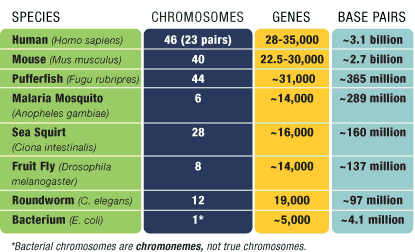|
AN INTRODUCTION TO GENOMICS:
THE HUMAN GENOME AND BEYOND
Understanding DNA
Comparing the DNA sequence patterns of humans side-by-side with those of well-studied "model organisms" such as the fruit fly, mouse, pufferfish, and sea squirt is one of the most powerful strategies for identifying human genes and determining how they're regulated and what they do. Conserved sequences—DNA patterns that we share with other organisms—are likely to have important functions or they would have disappeared as the organisms evolved.
Along with helping identify genes and their functions, comparative genomics is shedding light on the functions of the noncoding sequences of DNA found within and between the genes. These segments can regulate gene expression, the process involved in determining when and where in the organism a given gene is turned on or off. Understanding the complex orchestration of gene and protein networks is a crucial aspect of contemporary biomedical research.
The web of life
We may not look alike, but humans, cows, fish, and microbes have a lot in common. We all retain similar DNA sequences inherited from our shared ancestors who lived hundreds of millions of years ago. Humans share many genes with mice, frogs, flies, and even bacteria and yeast, since their essential functions have been inherited intact over long periods of time.

The original estimate of more than 100,000 human genes was adjusted to between 28,000 and 35,000 when the draft human genome sequence was published in February 2001.
Sequencing genomes
While the numbers of chromosomes, genes, and base pairs in the genomes of different organisms vary, their fundamental structures are very similar, and the techniques for sequencing and studying them are the same. Whole genome shotgun sequencing is used to determine the order of the bases of an entire genome.
Prepared by the Department of Energy's Joint Genome Institute and the Technical & Electronic Information Department, Lawrence Berkeley National Laboratory, with support from the Department of Energy Office of Science, Biological and Environmental Research Program.
Information taken from the Joint Genome Institute: Joint Genome Institute authored documents are sponsored by the U.S. Department of Energy under Contracts W-7405-Eng-48, DE-AC02-05CH11231, and W-7405-ENG-36. Accordingly, the U.S. Government retains a nonexclusive, royalty-free license to publish or reproduce these documents, or allow others to do so, for U.S. Government purposes. All documents available from this server may be protected under the U.S. and Foreign Copyright Laws and permission to reproduce them may be required. The public may copy and use this information without charge, provided that this Notice and any statement of authorship are reproduced on all copies. JGI is not responsible for the contents of any off-site pages referenced.
Printer-friendly page
All content © 2006-08 by Lori Andrews.
loriandrews.com |
